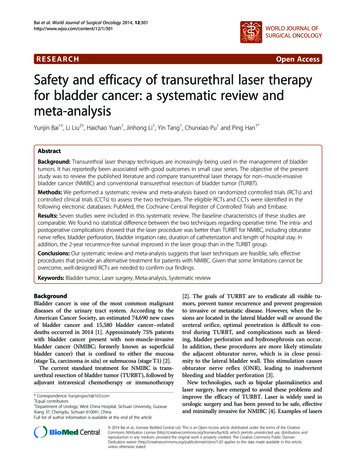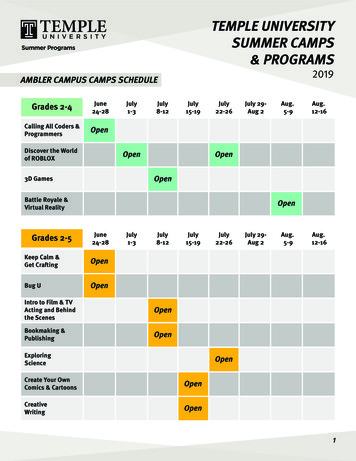
Transcription
Bai et al. World Journal of Surgical Oncology 2014, 12:301http://www.wjso.com/content/12/1/301WORLD JOURNAL OFSURGICAL ONCOLOGYRESEARCHOpen AccessSafety and efficacy of transurethral laser therapyfor bladder cancer: a systematic review andmeta-analysisYunjin Bai1†, Li Liu2†, Haichao Yuan1, Jinhong Li1, Yin Tang1, Chunxiao Pu1 and Ping Han1*AbstractBackground: Transurethral laser therapy techniques are increasingly being used in the management of bladdertumors. It has reportedly been associated with good outcomes in small case series. The objective of the presentstudy was to review the published literature and compare transurethral laser therapy for non–muscle-invasivebladder cancer (NMIBC) and conventional transurethral resection of bladder tumor (TURBT).Methods: We performed a systematic review and meta-analysis based on randomized controlled trials (RCTs) andcontrolled clinical trials (CCTs) to assess the two techniques. The eligible RCTs and CCTs were identified in thefollowing electronic databases: PubMed, the Cochrane Central Register of Controlled Trials and Embase.Results: Seven studies were included in this systematic review. The baseline characteristics of these studies arecomparable. We found no statistical difference between the two techniques regarding operative time. The intra- andpostoperative complications showed that the laser procedure was better than TURBT for NMIBC, including obturatornerve reflex, bladder perforation, bladder irrigation rate, duration of catheterization and length of hospital stay. Inaddition, the 2-year recurrence-free survival improved in the laser group than in the TURBT group.Conclusions: Our systematic review and meta-analysis suggests that laser techniques are feasible, safe, effectiveprocedures that provide an alternative treatment for patients with NMIBC. Given that some limitations cannot beovercome, well-designed RCTs are needed to confirm our findings.Keywords: Bladder tumor, Laser surgery, Meta-analysis, Systematic reviewBackgroundBladder cancer is one of the most common malignantdiseases of the urinary tract system. According to theAmerican Cancer Society, an estimated 74,690 new casesof bladder cancer and 15,580 bladder cancer–relateddeaths occurred in 2014 [1]. Approximately 75% patientswith bladder cancer present with non-muscle-invasivebladder cancer (NMIBC; formerly known as superficialbladder cancer) that is confined to either the mucosa(stage Ta, carcinoma in situ) or submucosa (stage T1) [2].The current standard treatment for NMIBC is transurethral resection of bladder tumor (TURBT), followed byadjuvant intravesical chemotherapy or immunotherapy* Correspondence: hanpingwch@163.com†Equal contributors1Department of Urology, West China Hospital, Sichuan University, GuoxueXiang 37, Chengdu, Sichuan 610041, ChinaFull list of author information is available at the end of the article[2]. The goals of TURBT are to eradicate all visible tumors, prevent tumor recurrence and prevent progressionto invasive or metastatic disease. However, when the lesions are located in the lateral bladder wall or around theureteral orifice, optimal penetration is difficult to control during TURBT, and complications such as bleeding, bladder perforation and hydronephrosis can occur.In addition, these procedures are more likely stimulatethe adjacent obturator nerve, which is in close proximity to the lateral bladder wall. This stimulation causesobturator nerve reflex (ONR), leading to inadvertentbleeding and bladder perforation [3].New technologies, such as bipolar plasmakinetics andlaser surgery, have emerged to avoid these problems andimprove the efficacy of TURBT. Laser is widely used inurologic surgery and has been proved to be safe, effectiveand minimally invasive for NMIBC [4]. Examples of lasers 2014 Bai et al.; licensee BioMed Central Ltd. This is an Open Access article distributed under the terms of the CreativeCommons Attribution License (http://creativecommons.org/licenses/by/4.0), which permits unrestricted use, distribution, andreproduction in any medium, provided the original work is properly credited. The Creative Commons Public DomainDedication waiver ) applies to the data made available in this article,unless otherwise stated.
Bai et al. World Journal of Surgical Oncology 2014, 12:301http://www.wjso.com/content/12/1/301include the following: neodymium, yttrium aluminum garnet (Nd:YAG), potassium titanyl phosphate (also knownas green-light laser), holmium YAG (Ho:YAG) and a 2-μmcontinuous-wave laser (thulium:YAG (Tm:YAG) laser). Ofthese, holmium and the 2-μm laser TURBT are the mostfrequently applied treatments for NMIBC, and thesetreatments result in satisfactory outcomes [5]. However,because of insufficient well-documented evidence to date,it remains unknown whether laser TURBT is an effectiveand safe alternative to TURBT for NMIBC.In recent years, several studies directly comparingtransurethral laser therapy and TURBT have been published in an attempt to explore this issue. Although theoutcomes of NMIBC after transurethral laser treatmentwere reported to be similar to those after TURBT interms of oncologic and perioperative outcomes, theseremain a matter of debate because results have been restricted to small sample sizes and obtained from a singleresearch center. In addition, most studies have beennonrandomized controlled trials (NRCTs). NRCTs comparing laser treatment for bladder tumors as well asTURBT could either underestimate or exaggerate any truedifferences between the two procedures. However, theresults of a systematic review and meta-analysis of welldesigned NRCTs during surgical procedures were provenfeasible and exactly similar to those of contemporaneousrandomized controlled trials (RCTs) [6,7]. Consequently,we performed a systematic review of NRCTs using metaanalysis to determine whether there were any differencesbetween the intraoperative and postoperative outcomes inaddition to oncologic outcomes between these twoapproaches and determine whether transurethral lasertreatment techniques can be an appropriate alternatives toTURBT.MethodsThis study doesn’t involve human subjects and does notrequire Institutional Review Board review or consent. InMarch 2014, PubMed, the Cochrane Central Register ofControlled Trials (CENTRAL) (via Ovid) and EMBASE(via Ovid) were searched using the following terms:“urinary bladder neoplasm”, “transitional cell carcinoma”,“bladder cancer”, “bladder tumor”, “urinary bladdercancer” and “laser”. The article language was restrictedto English.Two authors separately evaluated all the potentially eligible studies without prior consideration of the results andassessed the methodological quality. For a study to beconsidered eligible, it had to meet the following criteria:(1) The study was a RCT or a controlled clinical trial(CCT); (2) the primary NMIBC had to be pathologicallyconfirmed; (3) the treatment intervention was transurethral laser therapy (excluding Nd:YAG laser due to its notcommonly being used in bladder cancer and havingPage 2 of 9several drawbacks, such as deep-tissue penetration thatlimits its use on filmy wall areas, particularly on the posterior side and dome of the bladder) of the bladder tumorversus conventional TURBT; (4) original data for dichotomous and continuous variables had to be provided orcalculated from the data source; and (5) measures of objective and/or subjective outcomes had to be clearly defined. Studies were excluded if they met the followingcriteria: (1) The study was not a RCT or CCT; (2) thestudy was an animal study; (3) patients were diagnosedwith recurrent bladder cancer, muscle-invasive bladdercancer, metastatic disease and/or upper urinary tract tumors; (4) patients had previous TURBT or transurethralresection of the prostate; and (5) there was combined useof laser and TURBT.The methodological quality of the included studies inour meta-analysis was assessed in accordance with theCochrane Handbook [8]. We evaluated the quality ofthese individual studies using the Downs and Black quality assessment method, in which a list of 27 criteria areused to evaluate both RCTs and NRCTs [9]. This qualityassessment scale assesses study reports, external validityand internal validity and has been ranked in the top sixquality assessment scales suitable for use in systematicFigure 1 Flow diagram of studies identified, includedand excluded.
Trials/yr.Designs/grade Downs and Treatment NO. ofAge (yr.)* Male (%) TumorTumor Size (cm)* Location(n)T Stage (n) Grade(n)Black scorepatientsMultiplicity*Lateral Other Ta CIS T1PUNLMP LowYang [11], 2014Retrospective, B 18Tao [12], 2013Retrospective, C 17Liu [13], 2013Zhong [16], 2010Prospective, B20Retrospective, C 16Xishuang [14], 2010 Prospective, B18Zhu [15], 2008Prospective, B17Muraro [17], 2005Retrospective, C 16KTP TURBT28 3245.3 42.578.6 78.1NR NRN/A N/A22 176 158 7 0 0 20 25 NR NRHighNR NR NR 4NRNRNRBai et al. World Journal of Surgical Oncology 2014, 12:301http://www.wjso.com/content/12/1/301Table 1 Baseline characteristics of included trialsPUNLMP papillary urothelial neoplasms of low malignant potential; CIS carcinoma in situ; KTP Potassium-titanyl-phosphate laser; HPS 120 W high performance system Green-light laser vaporization of bladdertumor; HoLRBT holmium laser resection of bladder tumor; TURBT transurethral resection of bladder tumor; 2 micron 2 micron continuous wave laser resection of bladder tumor; NR not reported;N/A not applicable;* Mean or median.Page 3 of 9
Bai et al. World Journal of Surgical Oncology 2014, 12:301http://www.wjso.com/content/12/1/301reviews [10]. A higher score was associated with higherstudy quality. The Downs and Black score ranges weregrouped into the following four quality levels: excellent(26 to 28), good (20 to 25), fair (15 to 19) and poor( 14). At the same time, a grading system (GRADE) [8]was used to assess the quality of each study included in ourmeta-analysis, which was based on the following five factors: (1) no limitations of the study design, (2) consistencyof the results, (3) directness of evidence, (4) sufficient dataand (5) minimal potential publication bias. The overallquality of a systematic review was considered to be high ifmultiple included studies with a low risk of bias providedconsistent results regarding outcome. The quality of evidence was downgraded by one level if one of the abovementioned factors was not met. Similarly, if two or threefactors were not met, the level of evidence was downgradedby two or three levels, respectively. Therefore, the GRADEapproach resulted in four levels of quality of evidence: high(A), moderate (B), low (C) and very low (D).Data extraction was independently performed by twoauthors and was then cross checked. Any disagreementbetween the extracting authors was resolved by consensusof all authors. The primary outcome measures includedONR rate, bladder perforation rate, and recurrence-freesurvival, whereas the secondary outcomes included operative time, bladder irrigation rate, and the duration ofcatheterization and length of hospital stay. In addition tothe abovementioned outcomes, additional data, includingthe authors’ names, publication year, number of patientsand their age, tumor multiplicity, tumor size, and tumorstage/grade, were extracted from each included studiesand recorded as baseline characteristics.Statistical analysis was conducted using RevMan5.2.5.The risk ratio (RR) was used for dichotomous variables,and mean difference (MD) was used for continuous data,both with 95% confidence intervals (CI). Methodologicalheterogeneity was assessed during selection, and statistical heterogeneity was measured using the χ2 test and I2scores. If χ2 heterogeneity was reported as P 0.1 andI2 50%, heterogeneity was considered low. A fixedeffects model was used to assess the data of includedstudies with minimal or no heterogeneity. In contrast, arandom-effects model was applied. A P-value for significance was set at 0.05.ResultsThe literature search yielded 689 reports, of which 671were excluded on the basis of title or abstract that wasirrelevant to the topic, and 8 were excluded from theremaining 15 literature after reading the full text. Therefore, data from seven studies were included in this systematic review. All of the included studies reported onvarious outcomes that were suitable for pooling into ameta-analysis. There were eight contrast trials, and onePage 4 of 9study included two contrast tests. Figure 1 reveals theoutcomes of the literature search. The baseline and general characteristics of the included studies were extracted and are listed in Table 1. All seven study reportsincluded the tumor size, operation time, bladder irrigation, duration of catheterization and length of hospitalstay, as well as follow-up data. Five studies included reports on ONR [11-15], and six described bladder perforation [11-16]. All data from these studies that werepresented as means standard deviation or rates, whichallowed for a meta-analysis, were pooled and analyzed.Based on the Cochrane Collaboration’s tool for assessing risk of bias, the baseline characteristics of the included studies were comparable. Table 1 presents thedemographics of the studies, including number of patients, age, sex, location, T stage and grade. There wereno significant differences between transurethral laser resection and TURBT in any of the demographic parameters (P 0.05). However, there were different levels ofbias (Figure 2). Most of the studies included in our analysis were retrospective [11,12,16,17], and two wereRCTs [13,15]. All included studies did not state that theyFigure 2 Quality assessment. Chart summarizes our judgmentsabout each risk of bias item for each included study. References:Liu et al. [13], Muraro et al. [17], Tao et al. [12], Xishuang et al. [14],Yang et al. [11], Zhong et al. [16] and Zhu et al. [15].
Bai et al. World Journal of Surgical Oncology 2014, 12:301http://www.wjso.com/content/12/1/301were blinded, although studies on surgery can be singleblinded. The outcomes of the included studies wereclear, except for those on ONR and bladder perforation[16,17]. Overall, four studies had low risk of bias, andthree [15-17] had medium risk of bias. The Downs andBlack quality assessment scores of all studies were 14.The quality of results in research methodology evaluation is listed in Table 1.No statistical difference was found in operation timebetween transurethral laser treatment and TURBT forNMIBC (MD 0.69, 95% CI [ 1.62, 0.24], P 0.14)(Figure 3). Six studies have compared transurethral lasermanagement of bladder tumors with TURBT, bladderirrigation, the duration of catheterization and length ofhospital stay, but these studies exhibited heterogeneity.We repeated the sensitivity analysis for these studies andobtained similar results. Using a random-effects model,the results of meta-analysis showed significant differences between the two groups with regard to bladderirrigation (RR 0.36; 95% CI [0.19, 0.69], P 0.002)Page 5 of 9(Figure 4), the duration of catheterization (MD 1.26,95% CI [ 1.79, 0.73], P 0.00001) (Figure 3) and lengthof hospital stay (MD 1.52, 95% CI [ 1.83, 1.20],P 0.00001) (Figure 3). The two groups showed significant differences regarding ONR (RR 0.07, 95% CI[0.02, 0.23], P 0.0001) (Figure 4) and bladder perforation(RR 0.16, 95% CI [0.05, 0.54], P 0.003) (Figure 4).Although the 1-year recurrence-free survival did not statistically differ between the two groups (RR 1.04, 95% CI[0.98, 1.10], P 0.22) (Figure 5), the 2-year recurrencefree survival (RR 1.13, 95% CI [1.04, 1.22], P 0.002)(Figure 5) improved in the laser group compared to theTURBT group.DiscussionTURBT is commonly used in the diagnosis and treatment of primary NMIBC because it can provide adequate tissue samples for pathological examination andall visible tumors can be excised efficiently. However,TURBT is associated with potential risks, including theFigure 3 Cumulative analysis of studies comparing laser and transurethral resection of bladder tumors with respect to perioperative clinicaldata. (A) Operation time (minute). (B) Duration of catheterization (day). (C) Length of hospital stay (day). IV, Inverse variance; TURBT, Transurethral resectionof bladder tumor. References: Liu et al. [13], Tao et al. [12], Xishuang et al. [14], Yang et al. [11], Zhong et al. [16] and Zhu et al. [15].
Bai et al. World Journal of Surgical Oncology 2014, 12:301http://www.wjso.com/content/12/1/301Page 6 of 9Figure 4 Cumulative analysis of studies comparing laser and transurethral resection of bladder tumors with respect to intraoperativecomplications. (A) Bladder irrigation. (B) Obturator nerve reflex. (C) Bladder perforation. M-H, Mantel-Haenszel; TURBT, Transurethral resection of bladdertumor. References: Liu et al. [13], Muraro et al. [17], Tao et al. [12], Xishuang et al. [14], Yang et al. [11], Zhong et al. [16] and Zhu et al. [15].occurrence of ONR during surgery, especially for lesionslocated in the lateral bladder wall, which may lead tobladder perforation. Although the success rate of thetransperineal obturator nerve block to prevent adductormuscle contractions during TURBT is 83.8% to 85.7%[18], this approach still may not completely prevent theoccurrence of ONR. Fortunately, the development ofbipolar plasmakinetics and the advent of modern lasertherapy techniques have provided more alternatives toTURBT for bladder tumors [12,14], which may avoid theabove-listed shortcomings.The use of laser techniques in urology was first reportedby in 1978 Staehler et al. [19], who described the successfuldestruction of bladder tumors using Nd:YAG laser surgery.This laser is used mainly for the treatment of benign prostatic hyperplasia [20]. The advent of new laser techniquesand improvements in conventional TURBT resulted in theabolishment of Nd lasers in the treatment of bladdertumors [5]. Therefore, in our systematic review and metaanalysis, we did not include Nd laser techniques; instead,we analyzed only commonly used lasers, such as greenlight, Ho:YAG and the 2-μm continuous-wave lasers.Our review of the published data of seven comparativestudies suggested that the 2-year recurrence-free survivalof the laser group was better than that of the conventional TURBT group for NMIBC. Compared with conventional TURBT, laser techniques can be used to excisetumors without contact, and effective coagulation usinglaser vaporization can seal off the blood and lymph vessels around the tumors and reduce the implanted metastasis of tumor cells and distant tumor recurrence [21].Furthermore, the use of laser combined with endoscopictechniques can accurately excise tumors, significantlyreduce the blind areas and reduce the residual tumor. In2001, laser techniques achieved the level of completeand precise removal of tumors from the submucosa or
Bai et al. World Journal of Surgical Oncology 2014, 12:301http://www.wjso.com/content/12/1/301Page 7 of 9Figure 5 Cumulative analysis of studies comparing laser and transurethral resection of bladder tumors with respect to recurrence-freesurvival. (A) 1-year recurrence-free survival. (B) 2-year recurrence-free survival. M-H, Mantel-Haenszel; TURBT, Transurethral resection of bladder tumor.References: Liu et al. [13], Muraro et al. [17], Tao et al. [12], Xishuang et al. [14], Yang et al. [11], Zhong et al. [16] and Zhu et al. [15].superficial muscle layers [22,23]. These results were attributed to its dual functions of vaporization and resection,which provided sufficient tissue for pathological examination to assess tumor grade and stage. They also affordeda theoretical basis for follow-up treatments, except forgreen-light laser, because all of the tumor was vaporized.Some scholars deemed that the recurrence rate of lasertreatment for bladder tumors is lower than that of TURBTbecause of an active immune effect of the laser techniques[23]. In contrast, an inadequate resection depth of thebasal parts of tumors during TURBT to avoid bladderperforation may have resulted in a higher recurrence rate[24]. In addition, it is easier to form encrustation whenusing electrocautery to stop bleeding during TURBT,which may result in tumor cells remained in situ [25].In our meta-analysis, intraoperative complicationswere less frequently observed in the laser group than inthe TURBT group. Bladder perforation is the mostserious complication of TURBT, and the other majorcauses are thermal injury and ONR during TURBT.When TURBT was applied to remove lateral tumors, thecurrent flow passing through the obturator nerve maycause ONR, which results in sudden muscle contractionsand bladder perforation. Furthermore, the temperatureranged from 100 C to 300 C at the treatment site,thereby causing thermal injury [26]. In contrast, whenlaser was applied to remove the tumor tissue, no currentflow was produced during the procedure. This procedurecould not stimulate the obturator nerve, especially inpatients with NMIBC, because tumors were located inthe lateral bladder wall. Therefore, bladder perforationinduced by ONR can be avoided by using laser techniques. In addition, thermal injury at the treatment siteis minimized, which could be attributed to the absenceof a strong local electrical field.Laser techniques without deep penetration are less invasive and therefore reduce pain perception and cause minimal bleeding. In addition, the power of the laser can beadjusted according to tumor size. The use of a laser alsoprovides surgeons with a clearer tumor view. Furthermore, satisfactory hemostatic effects are obtained with alaser, because it can form a coagulation zone of 1- to2-mm thickness on the surface of the wounded tissue[12]. Under these circumstances, a laser can effectivelyavoid additional damage due to repeated stanch, reducebladder irrigation and shorten the catheterization timeand length of hospital stay. Therefore, patients have a highdegree of overall satisfaction with minimal complications.When we pooled the included studies and assessed postoperative complications and clinical data, we found someheterogeneity. When we performed sensitivity analysis onthe included studies, similar results were obtained. Thismay be explained by the observation that the patients werenot discharged until the final postoperative pathological
Bai et al. World Journal of Surgical Oncology 2014, 12:301http://www.wjso.com/content/12/1/301findings were reported [13,15,16]. In addition, Tao et al.[12] considered that most patients with a newly diagnosedbladder cancer require a hospital stay until catheterremoval. However, we believe that different doctors havedifferent standards for bladder irrigation, catheter removaland hospital discharge. Therefore, special considerationshave to be incorporated when data regarding bladderirrigation, catheterization and hospitalization are pooled.Compared with previous reviews [4,5], our metaanalysis contained one RCT and more strict quality assessment methods were used. We evaluated the qualityof these individual studies using the Downs and Blackquality assessment method and also evaluated the risk ofbias. Kramer et al. [5] published a systematic review, theresults of which showed that Ho:YAG and Tm:YAGseem to offer alternatives in the treatment of bladdercancer, but there is no limit on the types of studiesincluded and no quantitative analyses. In our review, thestudies were RCTs or CCTs, and we also conducted ameta-analysis, the results of which showed that laser hasseveral advantages over conventional TURBT. Therefore,compared with the results reported by Kramer et al., wedeem our results more reliable. The recent review byTeng et al. [4], who compared only Ho:YAG laser withconventional TURBT, showed that holmium laser is safeand efficient for the treatment of NMIBC, with resultssimilar to ours. However, we also compared green-lightand Tm:YAG lasers with TURBT. Therefore, our researchis more comprehensive. However, we also acknowledgethat certain inherent limitations in the studies included inour meta-analysis cannot be ignored when interpretingour data. The main limitation of the present review is thatonly seven studies of small patient cohorts were included,and most of these were retrospective. Therefore, largescale and multicentered RCTs should be performed toevaluate the safety and efficacy of lasers for NMIBC. Furthermore, there were differences in the length of followup periods, so the standard scheme and results from thelong-term follow-up studies are expected. Also, none ofthe studies used a systematic classification system forassessing complications. In other words, there was nounified standard of bladder irrigation, catheter uproot andhospital discharge in the included studies, which resultedin heterogeneity in our pooled analysis. Nevertheless,despite varying degrees of differences in the data from theincluded studies, it is noteworthy that the results of eachstudy are meaningful. In the future, the major clinicalindices should have a unified standard, because only inthis way will studies become more comparable, resultingin more convincing pooled analyses.ConclusionsBased on the data included in our meta-analysis, transurethral laser resection techniques offer improved safetyPage 8 of 9and tolerability as well as enhanced recurrence-free survival compared with TURBT for NMIBC. Therefore, lasertechniques are feasible, safe and effective procedures thatprovide an alternative treatment for patients with NMIBC.Larger, prospective, multicentered studies with a longerfollow-up period should be performed to reinforce thepresent findings.AbbreviationsCCT: Controlled clinical trial; CI: Confidence interval; NMIBC: Non-muscleinvasive bladder cancer; ONR: Obturator nerve reflex; OR: Odds ratio;RCT: Randomized controlled trial; RR: Relative risk; TURBT: Transurethralresection of the bladder tumor.Competing interestsThe authors declare that they have no competing interests.Authors’ contributionsYB and LL performed statistical analysis and wrote the manuscript. JL, HYand YT performed the literature search and stratified the data. CP and YBprovided meaningful discussion key points. PH revised and edited themanuscript. All authors read and approved the final manuscript.Authors’ informationYunjin Bai and Li Liu are considered as co-first authors.AcknowledgementsThis work was collectively supported by grant 81270841 from the NationalNatural Science Foundation of China and grant 2013SZ0034 from theScience & Technology Pillar Program from the Science & TechnologyDepartment of Sichuan Province. The funders had no role in study design,data collection and analysis, decision to publish or preparation of themanuscript.Author details1Department of Urology, West China Hospital, Sichuan University, GuoxueXiang 37, Chengdu, Sichuan 610041, China. 2Department of Pediatrics, WestChina Second University Hospital, Sichuan University, Renminnan Road 20,Chengdu, Sichuan 610041, China.Received: 8 April 2014 Accepted: 8 September 2014Published: 25 September 2014References1. Siegel R, Ma J, Zou Z, Jemal A: Cancer statistics, 2014. CA Cancer J Clin2014, 64:9–29.2. Babjuk M, Burger M, Zigeuner R, Shariat SF, van Rhijn BW, Compérat E,Sylvester RJ, Kaasinen E, Böhle A, Palou Redorta J, Rouprêt M: EAUguidelines on non–muscle-invasive urothelial carcinoma of the bladder:update 2013. Eur Urol 2013, 64:639–653.3. Golan S, Baniel J, Lask D, Livne PM, Yossepowitch O: Transurethral resectionof bladder tumour complicated by perforation requiring open surgicalrepair–clinical characteristics and oncological outcomes. BJU Int 2011,107:1065–1068.4. Teng JF, Wang K, Yin L, Qu FJ, Zhang DX, Cui XG, Xu DF: Holmium laserversus conventional transurethral resection of the bladder tumor.Chin Med J (Engl) 2013, 126:1761–1765.5. Kramer MW, Bach T, Wolters M, Imkamp F, Gross AJ, Kuczyk MA, MerseburgerAS, Herrmann TR: Current evidence for transurethral laser therapy ofnon-muscle invasive bladder cancer. World J Urol 2011, 29:433–442.6. Tsivgoulis G, Eggers J, Ribo M, Perren F, Saqqur M, Rubiera M, Sergentanis TN,Vadikolias K, Larrue V, Molina CA, Alexandrov AV: Safety and efficacy ofultrasound-enhanced thrombolysis: a comprehensive review and metaanalysis of randomized and nonrandomized studies. Stroke 2010, 41:280–287.7. Abraham NS, Byrne CJ, Young JM, Solomon MJ: Meta-analysis of welldesigned nonrandomized comparative studies of surgical procedures is asgood as randomized controlled trials. J Clin Epidemiol 2010, 63:238–245.8. Higgins JPT, Green S: Cochrane Handbook for Systematic Reviews ofInterventions (version 5.1.0) [updated March 2011]. The Cochrane
Bai et al. World Journal of Surgical Oncology 2014, boration; 2014. [http://handbook.cochrane.org/] (accessed 15September 2014).Downs SH, Black N: The feasibility of creating a checklist for the assessmentof the methodological quality both of randomised and non-randomisedstudies of health care interventions. J Epidemiol Community Health 1998,52:377–384.Ni S, Tao W, Chen Q, Liu L, Jiang H, Hu H, Han R, Wang C: Laparoscopicversus open nephroureterectomy for the treatment of upper urinarytract urothelial carcinoma: asystematic review and cumulative analysis ofcomparative studies. Eur Urol 2012, 61:1142–1153.Yang D, Xue B, Zang Y, Liu X, Zhu J,
Bladder cancer is one of the most common malignant diseases of the urinary tract system. According to the American Cancer Society, an estimated 74,690 new cases of bladder cancer and 15,580 bladder cancer-related deaths occurred in 2014 [1]. Approximately 75% patients with bladder cancer present with non-muscle-invasive











